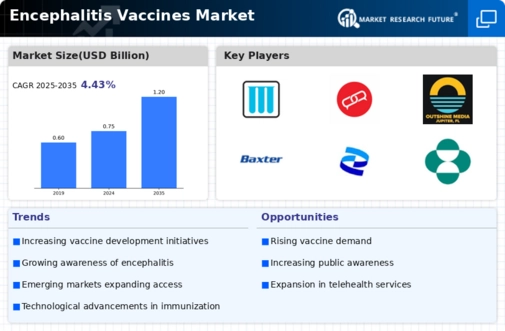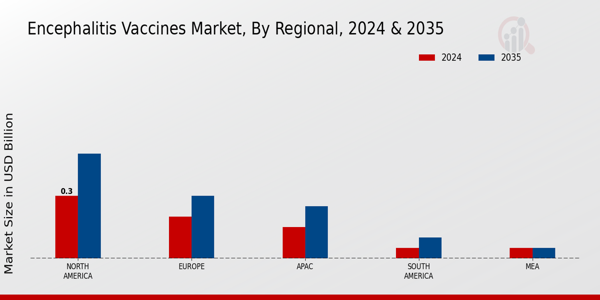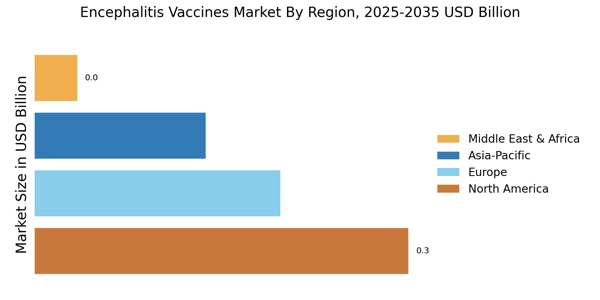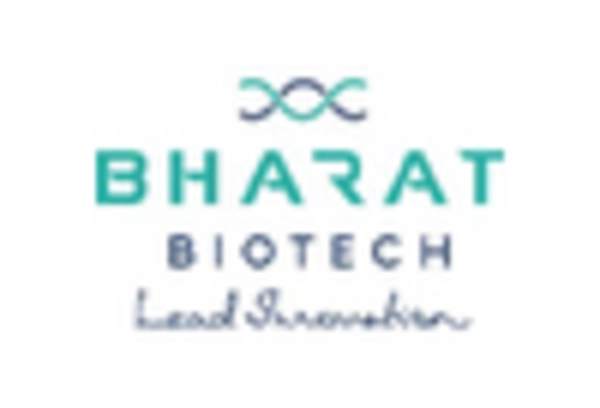Growing Public Health Awareness
The increasing public health awareness regarding encephalitis is a significant driver for the Encephalitis Vaccines Market. Educational campaigns aimed at informing the public about the risks associated with encephalitis and the benefits of vaccination are gaining traction. Health organizations are actively promoting vaccination as a preventive measure, which is likely to enhance public perception of the importance of encephalitis vaccines. This heightened awareness may lead to increased vaccination rates, thereby expanding the market. Additionally, as more individuals become informed about the potential consequences of encephalitis, the demand for vaccines is expected to rise. The focus on preventive healthcare is likely to further bolster the Encephalitis Vaccines Market.
Advancements in Vaccine Technology
Technological advancements in vaccine development are transforming the Encephalitis Vaccines Market. Innovations such as mRNA technology and recombinant vaccines are enhancing the efficacy and safety profiles of encephalitis vaccines. These advancements not only improve the immune response but also reduce the time required for vaccine development. The emergence of new vaccine platforms is likely to attract investment and research efforts, leading to a broader range of options for consumers. Furthermore, the ability to produce vaccines more efficiently may lower costs, making them more accessible to populations at risk. As these technologies continue to evolve, they are expected to play a crucial role in shaping the future landscape of the Encephalitis Vaccines Market.
Government Initiatives and Funding
Government initiatives aimed at combating infectious diseases play a pivotal role in shaping the Encephalitis Vaccines Market. Many countries have recognized the importance of vaccination in preventing encephalitis and have implemented national immunization programs. For example, funding for research and development of encephalitis vaccines has seen a significant increase, with governments allocating substantial budgets to enhance public health. This financial support not only facilitates the development of new vaccines but also ensures their accessibility to vulnerable populations. Furthermore, partnerships between governments and pharmaceutical companies are likely to foster innovation in vaccine technology, thereby enhancing the overall efficacy and safety of encephalitis vaccines. Such initiatives are expected to drive growth in the Encephalitis Vaccines Market.
Increasing Incidence of Encephalitis
The rising incidence of encephalitis cases is a critical driver for the Encephalitis Vaccines Market. Various factors, including climate change and increased human-animal interactions, have contributed to the spread of encephalitis viruses. For instance, the World Health Organization has reported a notable rise in cases attributed to mosquito-borne viruses, such as Japanese encephalitis. This trend underscores the urgent need for effective vaccination strategies. As awareness of these diseases grows, healthcare systems are likely to prioritize vaccination programs, thereby expanding the market. The increasing burden of encephalitis on public health systems may lead to enhanced funding and resources allocated for vaccine development and distribution, further propelling the Encephalitis Vaccines Market.
Rising Travel and Migration Patterns
The increase in travel and migration patterns is influencing the Encephalitis Vaccines Market. As people move across regions, the risk of encephalitis transmission rises, particularly in areas where the disease is endemic. Travelers to regions with high incidences of encephalitis are often advised to receive vaccinations, which boosts demand for these vaccines. According to health authorities, the number of international travelers has surged, leading to heightened awareness of the need for preventive measures against encephalitis. This trend suggests that vaccination campaigns targeting travelers could significantly impact the market. Additionally, as migration patterns evolve due to various socio-economic factors, the need for effective vaccination strategies becomes increasingly apparent, further driving the Encephalitis Vaccines Market.



















Leave a Comment